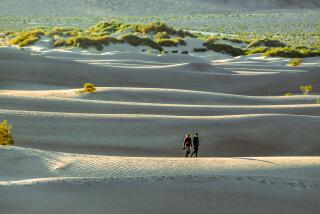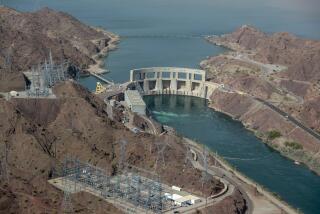Western Drought Is Leaving Vacationers High and Dry
LAKE MEAD, Nev. — Jason and Cori Babcock towed their new boat here Saturday from Southern California, expecting to ski carefree on one of the nation’s largest recreational lakes. Instead, they discovered what hundreds of thousands of other vacationers are encountering throughout much of the West this holiday weekend.
A stubborn decade-long drought is taking its toll on the great outdoors, upsetting boaters, campers and anglers who had grand plans to kick off the summer season.
No sooner had the Babcocks arrived from Granada Hills when they were warned by a park ranger that the water level is so low that rocky pinnacles are jutting perilously above the water’s surface, even in the middle of the lake. Cori Babcock was unsettled by the prospect of such a water-skiing hazard.
“That’s causing me some real concerns,” she said, her boat bobbing on the water’s surface that is nearly 50 feet lower than normal. “Seeing the water this low was very surprising.”
From Arizona to Wyoming, all along the West’s intermountain region, lake levels have dropped so significantly that many boat launching ramps lead only to blistered, sun-dried mud. Some diehard fishermen in Arizona are heaving their trolling boats over previously submerged boulders to get on the water. Once-vigorous fishing streams in Colorado are puny trickles.
Weekend vacationers also were being denied campgrounds in three states because of drought-enhanced fires: in Arizona, Colorado and New Mexico, where the northern part of the state was all but off-limits to campers.
“Northern New Mexico is closed tight as a drum,” said Richard Atkinson, manager of the state’s public lands information center. Four of the state’s five national forests and three state parks were closed because of fire danger. Among several fires burning there, one 40 miles north of Santa Fe had grown to 10,000 acres.
“We’re getting hundreds of calls, people saying, ‘Where can we go?’ They made reservations months ago, and we’re trying to send them elsewhere,” Atkinson said. “Ninety-nine percent of the people are understanding. They don’t want to risk life or limb, let alone set a fire. And right now in New Mexico, that can happen with a warm thought.”
Many New Mexico-bound tourists are re-routing to campgrounds in southern Colorado, only to run smack into the nation’s highest priority wildfire raging in the Pike and San Isabel national forests.
“By the time they get to us, they think there are fires everywhere,” said Lance Tyler, a forest recreation specialist. “It used to be that people thought ‘The West is on fire.’ Now they think, ‘The West is closed.’”
In fact, the vast majority of parks and forests remain open, but campfires are widely restricted, leaving children with the prospect of making s’mores over a propane camp stove.
In Rocky Mountain National Park in Estes Park, Colo., even with 6 inches of new snow at week’s end, fires were allowed only in established campgrounds.
The news of isolated forest fires was enough to keep some campers away from many national parks altogether this weekend, rangers reported.
“Out-of-state travelers sense that if there is a fire in Colorado, the whole state must be on fire, and that influences their plans,” said Larry Frederick, a ranger at Rocky Mountain National Park.
The Pike and San Isabel forests were at a heightened level of fire alert, scaring away some of the expected 10,000 tourists who cram the 101 campgrounds. Under those rules, no open fires are permitted.
Without the promise of a campfire, it seems, many American families don’t want to camp at all.
“It’s that primeval man-against-nature thing,” said Tyler. “The fire is a comfort. It keeps the wild animals at bay. Campfires are so attached to the tradition of camping that the two are hard to separate. There’s not a lot of romance sitting around a lantern telling stories.”
The only travelers who are not discouraged by fire restrictions are those in self-contained recreation vehicles, Tyler said. “They’re inside watching TV, not outside watching a fire.”
Colorado’s $600-million fishing economy is suffering under miserable conditions as river and stream levels plummet dangerously low. Wildlife experts fear fish will begin dying because of high water temperatures and loss of oxygen, and worry that the state’s fish habitat could be irreparably damaged by the end of summer.
The sad joke making the rounds in Colorado is that fly fishermen are leaving their elaborate gear at home and using nets to scoop up fish floundering in shallow water.
Similar reports are coming out of Arizona, where state wildlife officials have stopped stocking fish in lakes and reservoirs because water levels are so low.
In Wyoming’s Grand Teton National Park, Jackson Lake has dropped 15 feet, forcing the closure of one of the lake’s three marinas.
The drop at Lake Mead, about 35 miles southeast of Las Vegas, is giving rangers a rare opportunity to repair and lengthen boat launching ramps that normally are submerged. Over the last year alone, the lake has dropped 30 feet and is now dropping a foot a week.
Boaters on Saturday could make use of about half of the lake’s ramps, said Kay Rohde, a spokeswoman for the Lake Mead National Recreation Area.
“This is the lowest water level we’ve had since 1977, but back then it really wasn’t a problem because we were only getting 1 or 2 million visitors a year,” she said. Last year, 8.9 million visitors came to Lake Mead.
About 250,000 people were expected here Saturday, a postcard summer day with a deep blue sky and temperatures in the 90s. Families piled into ski boats, sailboats, speedboats and slow boats--large, flat-bottomed pontoon craft reverently called “party barges.”
But local boaters who have watched the lake drop over recent years worried that newcomers would be oblivious to the lake’s new perils.
“We know what to look out for, but I’m not so sure about the folks from California,” said Robert Slater of Las Vegas, loading 17 people onto his 30-foot pontoon boat for a day of scuba diving for lake-bottom treasures.
“You see these fast boats take out of here, and you know they’re not paying attention to what’s out there--sand bars and rocks,” he said.
Added Lanie Giordano, piloting a blazing white, 38-foot speedboat, “You can’t be goofing around out there because every week there are new little islands popping up.”
*
Cart reported from Denver, Gorman from Lake Mead.
More to Read
Sign up for Essential California
The most important California stories and recommendations in your inbox every morning.
You may occasionally receive promotional content from the Los Angeles Times.











